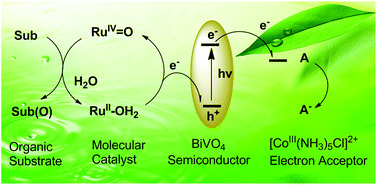Photocatalytic oxidation of organic compounds in a hybrid system composed of a molecular catalyst and visible light-absorbing semiconductor†
Abstract
Photocatalytic oxidation of organic compounds proceeded efficiently in a hybrid system with ruthenium aqua complexes as catalysts, BiVO4 as a light absorber, [Co(NH3)5Cl]2+ as a sacrificial electron acceptor and water as an oxygen source. The photogenerated holes in the semiconductor are used to oxidize molecular catalysts into the high-valent RuIV![[double bond, length as m-dash]](https://www.rsc.org/images/entities/char_e001.gif) O intermediates for 2e− oxidation.
O intermediates for 2e− oxidation.


 Please wait while we load your content...
Please wait while we load your content...